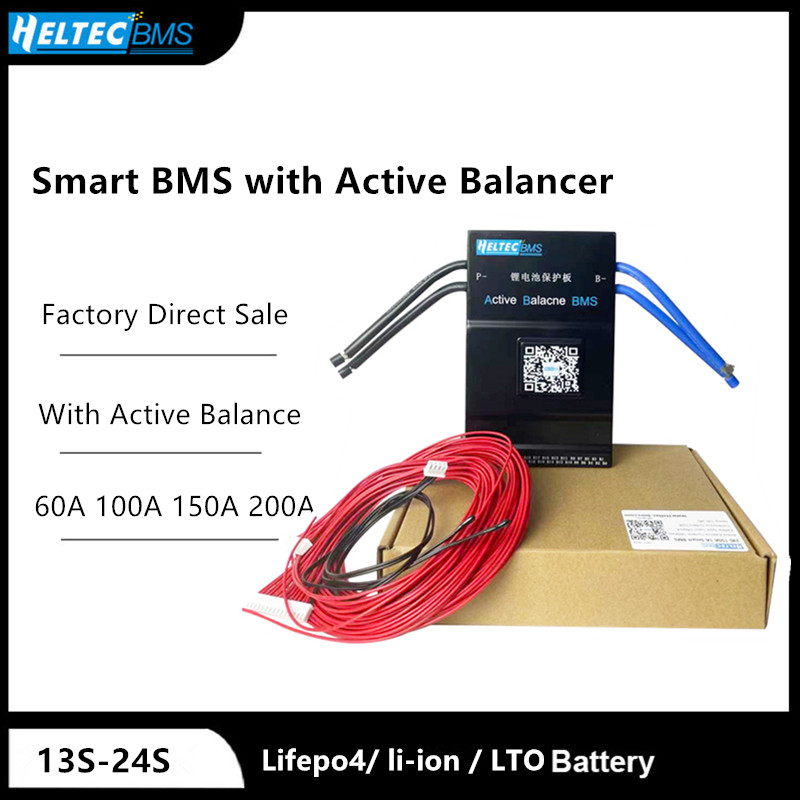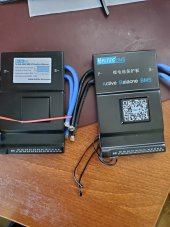Daddy Tanuki
Solar Wizard
well to get this thread back on track, I ordered and received two of the heltec 15-17 active balancers (capacitor types), and started making a wiring loom for them that will allow me to place the unit away form the battery a reasonable distance.
my battery pack is about 2' x 3.5' (approximately) and the short leads i soldered onto my BMS are already pissing me off. that and the short main cables on the bms.... but I digress.
Everything I have read on the heltecs says that once you hook them up, you cannot unhook them without frying them... why is this? and which harness should i plug in first? The ones I ordered have two plugs. one has B- and B+ 1-8 and the other plug has B+9-17. I quizzed the helltec support site about what to do with the extra lead (B+17) my pack is 2p16s and they said just do not hook it up???? WTF? (honestly their website is worthless but if the unit works....)
I saw other makers of active balancing units where you had to hook up the extras in a particular fashion to keep from blowing the units... so OK... why not the same for this? different architecture?? and why can I not unhook it after hooking it up? (without damage.)
If i were to try to unhook it after words.. which lead should I pull first? I was thinking just cut the negative line as after you take it out the rest of the board would not have a ground so it should not be able to fry anything without a complete circuit. (now you chuckle heads can make fun of my lack of knowledge.)
My 2p16s pack had while undergoing charge with no draw, a maximum divergence of 0.105 volts and that disappeared within 5 minutes of putting a load on the pack. (the bms went into protect and stopped charging. in actuality after watching an almost full charge cycle with it appears I have a runner number 4/5 and a slower to charge cells 11/12 and thats where the real issue was. 4/5 ramped up to 3.51 while 11/12 was at 3.405 and that tripped the alarm for the cell differential? (sorry some of these terms are new to me). BMS was set to max of 3.65 per cell, 58.4 for the pack, with a differential of .100 volts for alarm.
my settings are 54.4 max charge from the SC. I also found out it was drifting higher actually up to 55.36 which I double checked against the BMS and my multimeter, and reset the SC to accommodate the difference between what I was requesting and what I was getting.
as quickly as the cells leveled out with a draw on them i would almost bet that there would not have been any real difference if I had been running the inverter on them to start with. It only appears at the high end while charging (to date).
Currently with two days of overcast skies and running the A/C the entire first 12 hours to dry the cabin out I am at 49% and the high and low voltage difference is only 0.004 volts difference between highest cell and lowest, so I don't think I really need this per se, but I want to see if I can fill the battery a little fuller prior to the BMS shutting down the ports. I am trying to stay in the range of 3.0 and 3.4 volts to avoid the knee's of the curve but I do want to exploit the range as best I can. if I can get in another kilowatt of storage with one of these balancers I am willing to spend the money...hell i already did. and if these batteries pan out then I will probably order another 32 of them and double my capacity. I have the panels for it so why not?
my battery pack is about 2' x 3.5' (approximately) and the short leads i soldered onto my BMS are already pissing me off. that and the short main cables on the bms.... but I digress.
Everything I have read on the heltecs says that once you hook them up, you cannot unhook them without frying them... why is this? and which harness should i plug in first? The ones I ordered have two plugs. one has B- and B+ 1-8 and the other plug has B+9-17. I quizzed the helltec support site about what to do with the extra lead (B+17) my pack is 2p16s and they said just do not hook it up???? WTF? (honestly their website is worthless but if the unit works....)
I saw other makers of active balancing units where you had to hook up the extras in a particular fashion to keep from blowing the units... so OK... why not the same for this? different architecture?? and why can I not unhook it after hooking it up? (without damage.)
If i were to try to unhook it after words.. which lead should I pull first? I was thinking just cut the negative line as after you take it out the rest of the board would not have a ground so it should not be able to fry anything without a complete circuit. (now you chuckle heads can make fun of my lack of knowledge.)
My 2p16s pack had while undergoing charge with no draw, a maximum divergence of 0.105 volts and that disappeared within 5 minutes of putting a load on the pack. (the bms went into protect and stopped charging. in actuality after watching an almost full charge cycle with it appears I have a runner number 4/5 and a slower to charge cells 11/12 and thats where the real issue was. 4/5 ramped up to 3.51 while 11/12 was at 3.405 and that tripped the alarm for the cell differential? (sorry some of these terms are new to me). BMS was set to max of 3.65 per cell, 58.4 for the pack, with a differential of .100 volts for alarm.
my settings are 54.4 max charge from the SC. I also found out it was drifting higher actually up to 55.36 which I double checked against the BMS and my multimeter, and reset the SC to accommodate the difference between what I was requesting and what I was getting.
as quickly as the cells leveled out with a draw on them i would almost bet that there would not have been any real difference if I had been running the inverter on them to start with. It only appears at the high end while charging (to date).
Currently with two days of overcast skies and running the A/C the entire first 12 hours to dry the cabin out I am at 49% and the high and low voltage difference is only 0.004 volts difference between highest cell and lowest, so I don't think I really need this per se, but I want to see if I can fill the battery a little fuller prior to the BMS shutting down the ports. I am trying to stay in the range of 3.0 and 3.4 volts to avoid the knee's of the curve but I do want to exploit the range as best I can. if I can get in another kilowatt of storage with one of these balancers I am willing to spend the money...hell i already did. and if these batteries pan out then I will probably order another 32 of them and double my capacity. I have the panels for it so why not?





